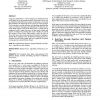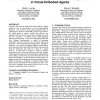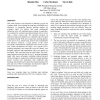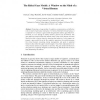BMVC
1998
14 years 2 months ago
1998
We investigate a holistic approach to real-time gaze tracking by means of a well-defined neural network modelling strategy combined with robust image processing algorithms. Based ...
HCI
2007
14 years 2 months ago
2007
In this paper, we investigate how to use future interaction technologies to enhance learning technologies. We examine in detail how tracking the mouse pointer and observing the use...
ETRA
2008
ACM
14 years 3 months ago
2008
ACM
Using gaze information as a form of input poses challenges based on the nature of eye movements and how we humans use our eyes in conjunction with other motor actions. In this pap...
ATAL
2008
Springer
14 years 3 months ago
2008
Springer
Currently, state of the art virtual agents lack the ability to display emotion as seen in actual humans, or even in hand-animated characters. One reason for the emotional inexpres...
Publication
In this paper, we focus on facial displays, eye gaze and head tilts to express social dominance. In particular, we are interested in the interaction of different non-verbal cues. W...
CHI
1999
ACM
14 years 5 months ago
1999
ACM
This work explores a new direction in utilizing eye gaze for computer input. Gaze tracking has long been considered as an alternative or potentially superior pointing method for c...
CHI
1999
ACM
14 years 5 months ago
1999
ACM
In this paper, we discuss why, in designing multiparty mediated systems, we should focus first on providing non-verbal cues which are less redundantly coded in speech than those n...
ETRA
2004
ACM
14 years 6 months ago
2004
ACM
Human eye gaze is a strong candidate to create a new application area based on human-computer interaction. To implement a really practical gaze-based interaction system, gaze dete...
3DPVT
2006
IEEE
14 years 7 months ago
2006
IEEE
This paper describes a non-intrusive method to estimate the gaze direction of a person by using stereo cameras. First, facial features are tracked with an adapted particle filter...
IVA
2007
Springer
14 years 7 months ago
2007
Springer
Gaze plays a large number of cognitive, communicative and affective roles in face-to-face human interaction. To build a believable virtual human, it is imperative to construct a ga...




